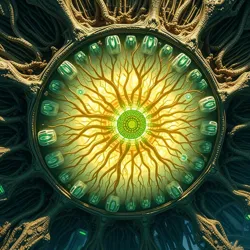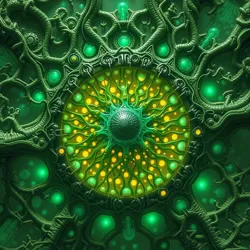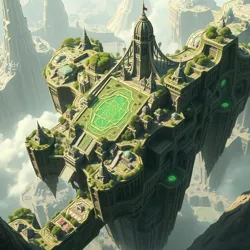Living Cities
Living Cities were a remarkable achievement of bioarchitectural engineering developed by the Serpent Lords of Mu during the Pre-Atlantean era. These massive, organic metropolises were grown rather than built, featuring self-healing structures and adaptive environments that responded to their inhabitants' needs.
 Cross-section of a Living City's central neural cluster, showing the primary synaptic pathways
Cross-section of a Living City's central neural cluster, showing the primary synaptic pathwaysStructure and Biology
Living Cities were created from specially engineered metacellular organisms that could grow and differentiate into various urban structures. The basic framework consisted of:
-
Living walls with respiratory systems that purified air
-
Neural networks that regulated city functions
-
Digestive systems that processed waste and generated nutrients
-
Circulatory channels that transported resources throughout the city
Notable Features
The cities demonstrated remarkable capabilities through their biosynthetic systems. Each metropolis possessed a central consciousness housed in the Neural Nexus, which coordinated all city functions and maintained homeostasis.
 The protective outer membrane of a Living City, showing bioluminescent communication patterns
The protective outer membrane of a Living City, showing bioluminescent communication patternsEnvironmental Integration
Living Cities practiced advanced forms of ecological symbiosis, creating perfectly balanced environments where:
-
Waste products were completely recycled into useful materials
-
Weather patterns were regulated through specialized organs
-
Local ecosystems were incorporated into the city's biological systems
Famous Examples
The most renowned Living City was Ophidia Prime, capital of the Serpent Lords' civilization. Other notable examples included:
-
Mycelium Haven, known for its fungal-based architecture
-
Chloros Nexus, which specialized in photosynthetic energy production
-
Neurovilla, famous for its advanced cognitive enhancement chambers
 Reconstructed image of residential structures in Ophidia Prime
Reconstructed image of residential structures in Ophidia PrimeLegacy and Influence
The principles behind Living Cities continue to influence modern bioengineering research. The discovery of preserved genetic blueprints in ancient ruins has led to breakthroughs in sustainable architecture and ecological engineering.
See Also
- Biological Transmutation
- Organic Computing Systems
- Urban Consciousness Networks
References
- Chronicles of Living Architecture
- Biological City Development
- Pre-Atlantean Urban Planning